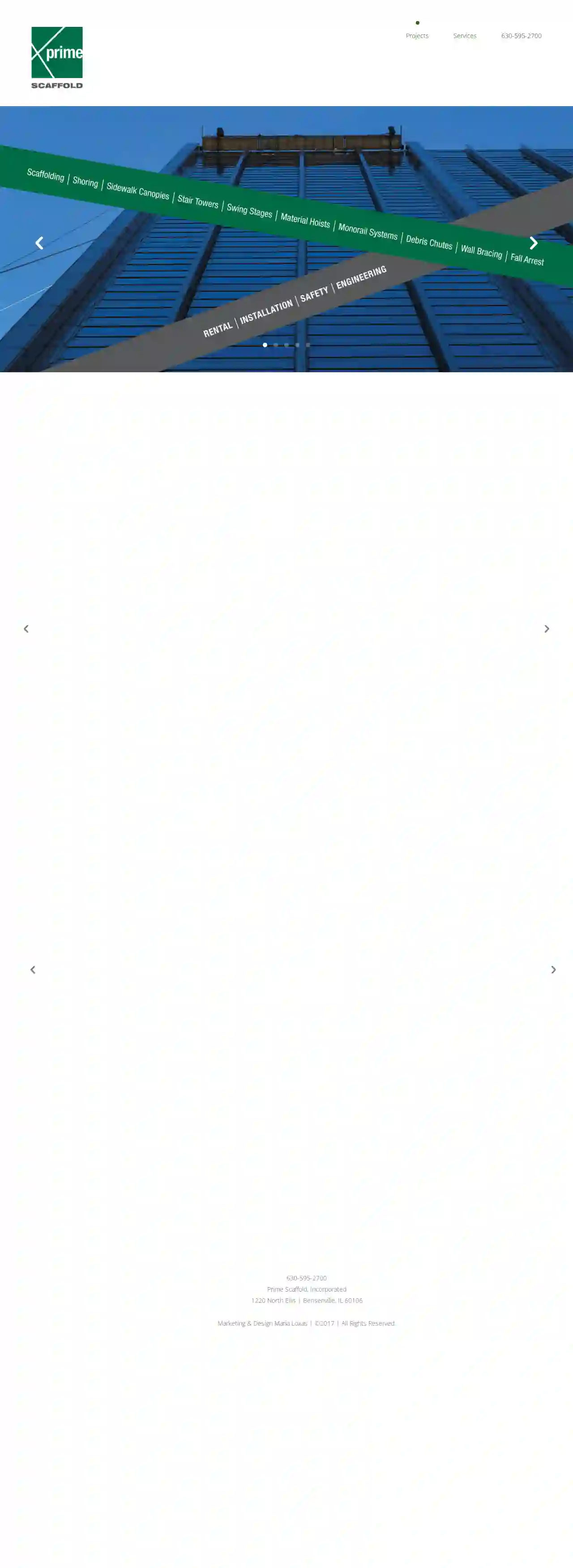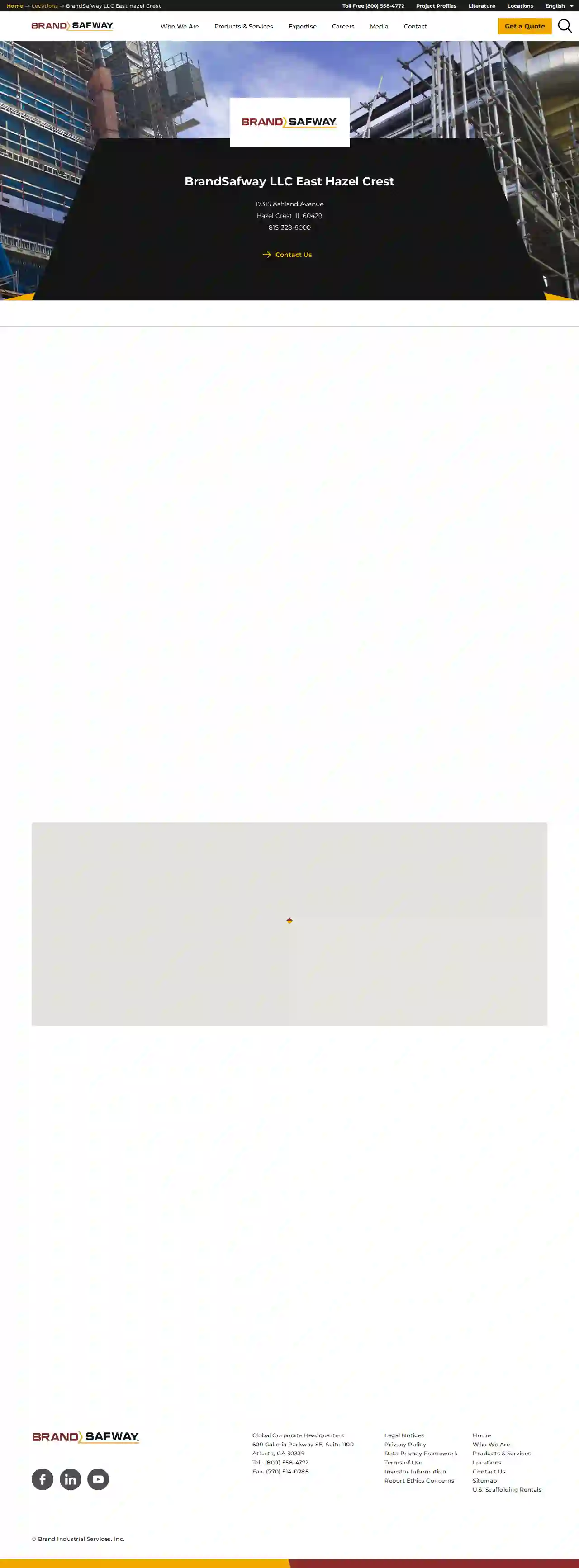Scaffolding Companies Summit
Top Scaffolding Builders in Summit
Get 3 FREE Scaffolding Builders quotes for your project today! Compare profiles, reviews, accreditations, portfolio, etc... and choose the best service.

Prime Scaffold Inc
4.19 reviews1220 North Ellis, Bensenville, 60106, USPrime Scaffold has been planning, designing, engineering and installing scaffolding systems in the Chicago metropolitan area for over 35 years. With a team of fully engaged and well-trained installers, they provide innovation, attention to detail, safety and excellent customer service. Their expertise meets specific project needs, working on large and small projects for local buildings, museums, airports, ballparks, skyscrapers and famous landmarks. They are OSHA compliant and have experience with complex projects such as the Garfield Park Conservatory and 401 North Michigan Avenue.
- Services
- Why Us?
- Gallery
Get Quote
Chicago Scaffolding Inc.
4.331 reviewsChicago, Illinois, 4824 W. Lake Street, 60644, USChicago Scaffolding Inc. (CSI), family owned and operated since 1988, has a rich history of experience and a family tradition of hard work and dependability. CSI prides itself on the core belief of providing exceptional service, quality, and safety to all clients. With a strong commitment to long-term professional relationships, we prioritize 100% customer satisfaction.
- Services
- Why Us?
- Accreditations
- Our Team
- Testimonials
- Gallery
Get Quote
BrandSafway LLC East Hazel Crest
123 BrandSafway Blvd, East Hazelcrest, 12345, USBrandSafway is a leading provider of access solutions, including scaffolding, aerial work platforms, and forming and shoring equipment. With a strong commitment to safety, quality, and customer satisfaction, BrandSafway offers a wide range of services tailored to meet the unique needs of clients across various industries. Their team of experienced professionals is dedicated to delivering innovative solutions that enhance efficiency and productivity, ensuring successful project outcomes.
- Services
- Why Us?
- Accreditations
- Our Team
- Testimonials
Get Quote
Walmart Supercenter
3.92600 S Eastwood Dr, Woodstock, 60098, USWelcome to Walmart! Walmart is a leading retailer offering a wide variety of products and services to customers across the globe. We strive to provide our customers with the best possible shopping experience, offering competitive prices, a vast selection of merchandise, and convenient shopping options. Our mission is to help people save money and live better, and we are committed to providing our customers with the best possible value. At Walmart, we believe in the power of community and are dedicated to supporting the communities we serve. We are proud to be a part of the Woodstock, IL community and are committed to providing our customers with the best possible shopping experience.
- Services
- Why Us?
- Gallery
Get Quote
MVC Painting
4.976 reviews800 E Northwest Hwy, Suite 750, 800 E Northwest Hwy Suite 750, Palatine, 60074, USWelcome to MVC Painting, a full-service painting company with over 15 years of experience in making our client's home improvement dreams become a reality. Our team of skilled professionals is dedicated to providing high-quality workmanship and customer service. We offer a wide range of services, including interior/exterior painting, drywall installation and repair, power washing, and more. With 100% customer satisfaction guaranteed, you can rely on us to get it right the first time. We have 5-star ratings from hundreds of customers just like you.
- Services
- Why Us?
- Gallery
Get Quote
Menards
4.2863 reviewsChampaign, USMenards is a leading home improvement store offering a wide range of products and services. With a strong commitment to quality and customer satisfaction, Menards provides tools, materials, and expert advice for various home improvement projects. Their mission is to provide excellent service, quality products, and competitive prices to help customers achieve their home improvement goals.
- Services
- Why Us?
- Gallery
Get Quote
Walmart Supercenter
43333 Grand Ave, Gurnee, 60031, USWalmart is a multinational retail corporation that operates a chain of hypermarkets, discount department stores, and grocery stores. With a strong commitment to providing quality products at affordable prices, Walmart aims to make everyday items accessible to everyone. The company's mission is to save people money so they can live better. Walmart offers a wide range of services including grocery shopping, electronics, home goods, and more. Their team consists of dedicated professionals who strive to provide excellent customer service. Walmart has multiple locations, including the Gurnee, IL store, which serves the local community with its extensive product offerings and convenient services.
- Services
- Why Us?
- Accreditations
- Our Team
- Testimonials
- Gallery
Get Quote
Walmart Supercenter
4.11404 S. Old Rand Rd, Lake Zurich, IL, 60047, USWalmart is a multinational retail corporation that operates a chain of hypermarkets, discount department stores, and grocery stores. With a strong commitment to providing quality products at affordable prices, Walmart aims to make everyday items accessible to everyone. The company's mission is to save people money so they can live better. Walmart offers a wide range of services including grocery shopping, electronics, home goods, and more. Their team consists of dedicated professionals who strive to provide excellent customer service. Walmart has multiple locations and serves various cities, ensuring convenience for customers across the country. They prioritize customer satisfaction and offer various trust factors such as a return policy, customer support, and a commitment to sustainability. Walmart also partners with various organizations to support local communities and promote environmental sustainability.
- Services
- Why Us?
- Accreditations
- Our Team
- Testimonials
- Gallery
Get Quote
International Equipment Inc
25218 S State St, Crete, 60417, USInternational Equipment, Inc. is a leading supplier and installer of high-quality scaffold equipment that enables your crews to work productively and safely at heights. Wherever you need your scaffolding to take you International Equipment has the right equipment for your project. Servicing all of the Midwest, International Equipment responds quickly to the needs of our customers, even during emergencies. We are a devoted team committed to providing the right product for your project with a personal touch that many larger competitors cannot match. We offer designs in augmented or virtual reality as well as 3D allowing you to see your design as it will appear when installed. You won’t pay for estimator’s guess work or extra rental charges for equipment you don’t need. Parts lists and installation costs are accurate with our estimating systems. With our resources and extensive inventory of equipment we are able to provide you with a variety of options to buy or rent. From project planning and installation of equipment to rigorous safety standards and training, International Equipment is there for you from start to finish.
- Services
- Why Us?
- Gallery
Get Quote
Menards
4.2605 reviews123 Main St, CityName, 00000, USMenards is a leading home improvement store that offers a wide range of products and services to help customers enhance their homes. With a strong commitment to customer satisfaction, Menards strives to provide the best shopping experience possible. From building materials to home decor, Menards has everything you need to make your house a home.
- Services
- Why Us?
Get Quote
Over 2,353+ Scaffolding Businesses on our platform
Our scaffolding contractors operate in Summit and surroundings!
ScaffoldingHQ has curated and vetted the Best Scaffolding Contractors arround Summit. Find a top & reliable business today.
Frequently Asked Questions About Scaffolding Companies
- Tube and Clamp Scaffolding: A traditional and versatile system using individual tubes and clamps. It's highly adaptable but requires more time to erect.
- System Scaffolding: Pre-engineered systems with modular components that fit together quickly. They offer speed and efficiency, especially for larger projects.
- Suspended Scaffolding: Hung from a roof or overhead structure, ideal for high-rise buildings or areas with limited ground access.
- Mobile Scaffolding: Mounted on wheels, allowing easy movement around a worksite. Suitable for tasks like painting or plastering.
- Specialized Scaffolding: Cantilever scaffolding, rolling towers, and other specialized systems cater to specific needs.
- Mobile Elevated Work Platforms (MEWPs): Scissor lifts, boom lifts, and other MEWPs offer flexible access for specific tasks.
- Mast Climbing Work Platforms (MCWPs): Ideal for high-rise construction, providing a stable working platform that can be raised incrementally.
- Suspended Access Equipment: Ropes and harnesses used for specific tasks like window cleaning or façade repairs.
- Ladders and Step Ladders: For shorter durations and limited working heights, provided they are used safely and appropriately.
- Encroaches onto public property (sidewalks, roads): Permits are usually needed from the local council or highway authority.
- Exceeds a certain height: Scaffolding above a specified height often requires a permit.
- Is erected in a conservation area or near a listed building: Special considerations and permits may apply.
What are the different types of scaffolding?
What are some alternatives to traditional scaffolding?
Do I need a permit for scaffolding in the USA?
What is a scaffolding hoist?
What are the different types of scaffolding?
- Tube and Clamp Scaffolding: A traditional and versatile system using individual tubes and clamps. It's highly adaptable but requires more time to erect.
- System Scaffolding: Pre-engineered systems with modular components that fit together quickly. They offer speed and efficiency, especially for larger projects.
- Suspended Scaffolding: Hung from a roof or overhead structure, ideal for high-rise buildings or areas with limited ground access.
- Mobile Scaffolding: Mounted on wheels, allowing easy movement around a worksite. Suitable for tasks like painting or plastering.
- Specialized Scaffolding: Cantilever scaffolding, rolling towers, and other specialized systems cater to specific needs.
What are some alternatives to traditional scaffolding?
- Mobile Elevated Work Platforms (MEWPs): Scissor lifts, boom lifts, and other MEWPs offer flexible access for specific tasks.
- Mast Climbing Work Platforms (MCWPs): Ideal for high-rise construction, providing a stable working platform that can be raised incrementally.
- Suspended Access Equipment: Ropes and harnesses used for specific tasks like window cleaning or façade repairs.
- Ladders and Step Ladders: For shorter durations and limited working heights, provided they are used safely and appropriately.
Do I need a permit for scaffolding in the USA?
- Encroaches onto public property (sidewalks, roads): Permits are usually needed from the local council or highway authority.
- Exceeds a certain height: Scaffolding above a specified height often requires a permit.
- Is erected in a conservation area or near a listed building: Special considerations and permits may apply.